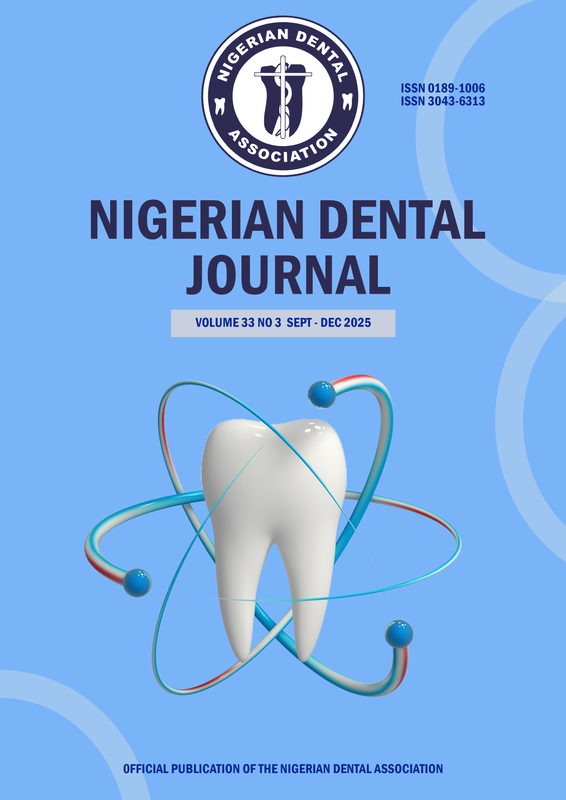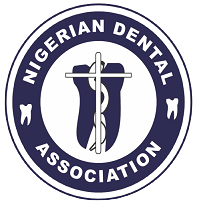Radiographic assessment of the health status of first permanent molars in pediatric groups in a Nigerian tertiary health institution: a retrospective cross-sectional study.
DOI:
https://doi.org/10.61172/pexr9284Abstract
Background: The first permanent molars (FPMs) are critical for maintaining normal masticatory functions and dentofacial harmony. However, they are highly susceptible to dental caries, especially in pediatric populations. This study aimed to radiographically assess the health status of first permanent molars in children aged 7 to 16 years at a Nigerian tertiary health institution, focusing on caries prevalence, structural anomalies, and periapical health.
Study Design: A retrospective cross-sectional of study panoramic radiographs was conducted.
Setting: Department of Oral Diagnostic sciences, Aminu Kano Teaching Hospital, Nigeria from January 2022 to December 2023, following ethical approval from the hospital's research and ethics Committee (approval number NHREC/29/01/2025/AKTH/EC/4004).
Participants: 317 children aged 7-16 years with mean age of approximately 11 years (SD = 3.26), 142 males (45.2%) and 172 females (54.8%) with artefact-free radiographs.
Outcome Measures: Primary: Caries prevalence. Secondary: Restoration status, missing, periapical pathology (rarefying osteitis), and structural anomalies (hypomineralization/fusion/taurodontism).
Key Results:
Caries: Overall caries prevalence across all first permanent molars was 36.9% (117/314); highest in mandibular molars 17.2% in mandibular left first permanent molar and 11.8% mandibular right first permanent molar , suggesting a greater predisposition of mandibular molars to carious lesions.
Restorative Interventions: were noted in only 5.4% (17/314) of the first permanent molars , with mandibular right first permanent molar exhibiting the highest frequency of restorations.
Missing Teeth: was infrequent, with the highest incidence 2.5% (8/314) observed in mandibular right first permanent molar.
Periapical Health: 95.2% (302/314) of cases were free of pathology, while 4.5% (14/314) predominantly ages 15-16, presented with rarefying osteitis, predominantly among individuals aged 15–16 years.
Structural Anomalies: Low frequencies, including hypomineralization 1%, (3/314), fusion 0.6%, (2/314), and taurodontism 1%, (3/314).
Conclusion: The findings suggest that while most first permanent molars remain structurally sound, caries prevalence is higher in mandibular molars, with limited restorative intervention observed. The low rates of periapical pathologies and structural anomalies indicate relatively good oral health, though older children showed increased susceptibility to dental decay and rarefying osteitis. These results highlight the need for preventive strategies, early intervention, and improved access to dental care to enhance pediatric oral health outcomes.
Downloads
References
1. American Dental Association (ADA). Tooth eruption. J Am Dent Assoc. 2006 [Available from: http://www.ada.org/~/media/ADA/Publications/Files/patient_58.ashx [Accessed 15–2-2016 2016].
2. Aksoy MC, Kocer G, Kucukesmen HC, Eroglu E, Senturk MF. Distribution and pattern of implant therapy in a part of the Turkish population. J Pak Med Assoc. 2016;66(10):1277-1280. PMID: 27686303
3. ADA Division of Communications; Journal of the American Dental Association; ADA Council on Scientific Affairs. For the dental patient. Tooth eruption: the permanent teeth. J Am Dent Assoc. 2006;137(1):127. doi:10.14219/jada.archive.2006.0031. PMID: 16457009.
4. Altindağ A, Yuce F, MAĞAT G. Investigation of the Radiological Status of Permanent First Molars in a Turkish Subpopulation. Clinical and Experimental Health Sciences. 2023;13(1):105–13.
5. Dean J.A, Jones J.E, Walker Vinson, L.A. McDonald and Avery’s Dentistry for the Child and Adolescent, 11th ed.; Elsevier: St. Louis, MO, USA, 2016; pp. 199–219.
6. Carvalho JC, Ekstrand KR, Thylstrup A. Dental plaque and caries on occlusal surfaces of first permanent molars in relation to stage of eruption. The Journal of Dental Research. 1989;68(5):773-779. DOI: 10.1177/00220345890680050401
7. Zühre A, Farid Bourzgui. IntechOpen Book Series Dentistry, Volume 5, Human Teeth: Key Skills and Clinical illustrations, Pathology and Abnormality of the First Permanent Molar among Children. DOI: http://dx.doi.org/10.5772/intechopen.89725
8. Zhu F, Chen Y, Yu Y, Xie Y, Zhu H, Wang H. Caries prevalence of the first permanent molars in 6-8 years old children. PLoS One. 2021;16(1):e0245345. DOI: 10.1371/journal.pone.0245345.
9. Al-Samadani, KH, Ahmad MS. Prevalence of First Permanent Molar Caries and Its Relationship to the Dental Knowledge of 9–12-Year Olds from Jeddah, Kingdom of Saudi Arabia. ISRN Dent. 2012; 2012: 1–6. DOI:10.5402/2012/391068
10. El Batawi H, Fakhruddin KS. Patterns of dental caries among school children assessed using Caries Assessment Spectrum and Treatment tool. Eur J Dent. 2017; 11:168-73.
11. MC Donald RE, Avery DR, Stookey Gk, Chin JR, Kow-alik JE. Dental caries in child and Adolescent In: MC Donald RE, Avery DR, Dean JA. Dentistry for the child and adolescent. 10th ed. St Louis, Missouri: Mosby Co; 2016. p. 155-156
12. Pitts NB, Zero DT, Marsh PD, Ekstrand K, Weintraub JA, Ramos-Gomez F et al. Dental caries. Nat. Rev. Dis. Primers 2017; 3: 17030.
13. Ozdemir D. Dental Caries: The Most Common Disease Worldwide and Preventive Strategies. Int. J. Biol. 2013; 5:55–61.
14. Kassebaum NJ, Bernabé E, Dahiya M, Bhandari B, Murray CJ, Marcenes W. Global burden of untreated caries: a systematic review and metaregression. Journal of dental research 2015; 94(5):650-658.
15. Kimmie-Dhansay, F, Bhayat A. Prevalence of dental caries in the permanent dentition amongst 12-year-olds in Africa: a systematic review and meta-analysis. BMC Oral Health 2022; 22:453. DOI: https://doi.org/10.1186/s12903-022-02489-4
16. Abullah S, Qazi HS, Maxood A. Dental caries status in 6-9 year old children. Pak Oral Dent J. 2008; 28(1):107-12.
17. Que L, Jia M, You Z, Jiang L, Yang C. Prevalence of dental caries in the first permanent molar and associated risk factors among sixth-grade students in Sao Tome Island. BMC Oral Health 2021; 21:483-493, DOI: https://doi.org/10.1186/s12903-021-01846-z
18. Kutesa A, Mwanika A, Wandera M. Pattern of dental caries in Mulago Dental School clinic, Uganda. African Health Sciences 2005; 5(1): 65–68, DOI: https://doi.org/10.4314/ahs.v5i1.6900.
19. Serban V, Maxim A, Balan A. Study on the caries of the first permanent molar in children aged between 6 and 13 years. J Ramanian Med Dent 2009; 13:138-41.
20. Togoo RA, Yaseen SM, Zakirulla M, Garni FA, Khoraj AL, Meer A. Prevalence of first permanent molar caries among 7-10 years old school going boys in Abha City, Saudi Arabia. J Int Oral Health 2011; 3:30-34.
21. Wyne AH. The Bilateral occurrence of dental caries among 12-13 and 15-19 year old school children. J Contemp Dent Pract. 2004; 5(1): 42-52. PMID: 14973559
22. Batchelor PA, Sheilham A. Grouping of tooth surfaces by susceptibility to caries: a study in 5-16 year-old children. BMC oral Health 2004; 4:2. DOI: https://doi.org/10.1186/1472-6831-4-2
23. Beresescu L, Beresescu GF, Esian D, Vlasa A, Benedek C, Sabau R et al. Regional epidemiological study on the dental status of the first permanent molar in Romanian School children. Dent. J. 2025; 13:26-36. DOI: https://doi.org/10.3390/dj13010026
Downloads
Published
Issue
Section
License
Copyright (c) 2025 Sabir Iya , Mohammad Kaura Abubakar, George O. Ewansiha , Bernard Emeka Ogbozor , Paul Mayellawos Karuwa, Jamiu Adetunji Abanikanda, Babatunde Olamide Bamgbose

This work is licensed under a Creative Commons Attribution 4.0 International License.
Open Access Statement
- We became fully Open Access since January 2023.
- Our new and archived materials are available free of charge on open basis and under a Creative Commons license as stated below.
Copyright statement
Copyright © 1999 The authors. This work, Nigerian Dental Journal by Nigerian Dental Association is licensed under Creative Commons Attribution 4.0 International License.

